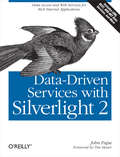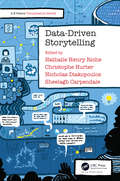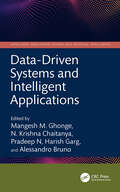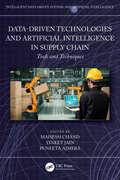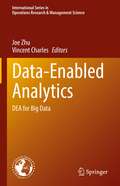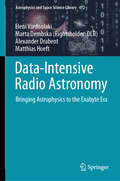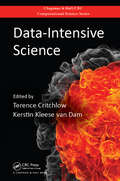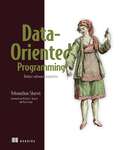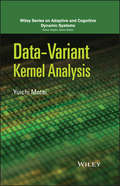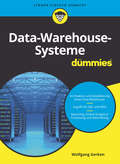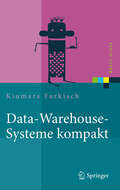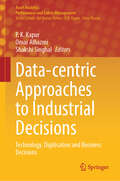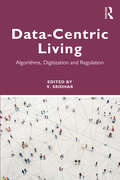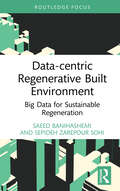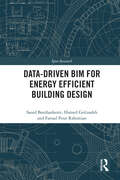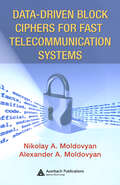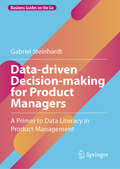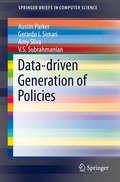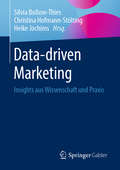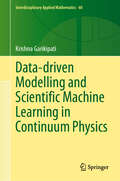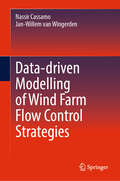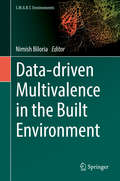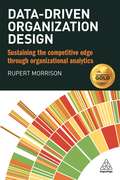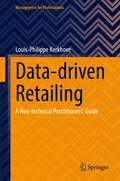- Table View
- List View
Data-Driven Services with Silverlight 2: Data Access and Web Services for Rich Internet Applications
by John PapaThis comprehensive book teaches you how to build data-rich business applications with Silverlight 2 that draw on multiple sources of data. Packed with reusable examples, Data-Driven Services with Silverlight 2 covers all of the data access and web service tools you need, including data binding, the LINQ data querying component, RESTful and SOAP web service support, cross-domain web service calls, and Microsoft's new ADO.NET Data Services and the ADO.NET Entity Framework. With this book, you will: Know when and how to use LINQ to JSON, LINQ to XML, and LINQ to Objects Learn how Silverlight 2 applications bind, pass, read, save, query, and present data Discover how your application can call web services to work with SOAP, REST, RSS, AtomPub, POX and JSON Design REST, ASMX, and WCF web services that communicate with Silverlight 2 Harness RESTful web services such as Digg, Amazon, and Twitter Retrieve and save data using the new Entity Framework and WCF Work with RESTful ADO.NET Data Services and its Silverlight client library to move data between your Silverlight application and a database Data-Driven Services with Silverlight 2 offers many tips and tricks for building data-rich business applications, and covers the scenarios you're most likely to encounter. Complete examples in C# and VB can be downloaded from the book's companion website.
Data-Driven Storytelling (AK Peters Visualization Series)
by Nathalie Henry Riche Christophe Hurter Nicholas Diakopoulos Sheelagh CarpendaleThis book presents an accessible introduction to data-driven storytelling. Resulting from unique discussions between data visualization researchers and data journalists, it offers an integrated definition of the topic, presents vivid examples and patterns for data storytelling, and calls out key challenges and new opportunities for researchers and practitioners.
Data-Driven Systems and Intelligent Applications (Intelligent Data-Driven Systems and Artificial Intelligence)
by Harish Garg Pradeep N Mangesh M. Ghonge N. Krishna Chaitanya Alessandro BrunoThis book comprehensively discusses basic data-driven intelligent systems, the methods for processing the data, and cloud computing with artificial intelligence. It presents fundamental and advanced techniques used for handling large user data, and for the data stored in the cloud. It further covers data-driven decision-making for smart logistics and manufacturing systems, network security, and privacy issues in cloud computing.This book: Discusses intelligent systems and cloud computing with the help of artificial intelligence and machine learning. Showcases the importance of machine learning and deep learning in data-driven and cloud-based applications to improve their capabilities and intelligence. Presents the latest developments in data-driven and cloud applications with respect to their design and architecture. Covers artificial intelligence methods along with their experimental result analysis through data processing tools. Presents the advent of machine learning, deep learning, and reinforcement technique for cloud computing to provide cost-effective and efficient services. The text will be useful for senior undergraduate, graduate students, and academic researchers in diverse fields including electrical engineering, electronics and communications engineering, computer engineering, manufacturing engineering, and production engineering.
Data-Driven Technologies and Artificial Intelligence in Supply Chain: Tools and Techniques (Intelligent Data-Driven Systems and Artificial Intelligence)
by Mahesh Chand Vineet Jain Puneeta AjmeraThis book highlights the importance of data-driven technologies and artificial intelligence in supply chain management. It covers important concepts such as enabling technologies in Industry 4.0, the impact of artificial intelligence, and data-driven technologies in lean manufacturing. "Provides solutions to solve complex supply chain management issues using artificial intelligence and data-driven technologies" Emphasizes the impact of a data-driven supply chain on quality management "Discusses applications of artificial intelligence, and data-driven technologies in the service industry, and lean manufacturing" Highlights the barriers to implementing artificial intelligence in small and medium enterprises Presents a better understanding of different risks such as procurement risks, process risks, demand risks, transportation risks, and operational risks The book comprehensively discusses the applications of artificial intelligence and data-driven technologies in supply chain management for diverse fields such as service industries, manufacturing industries, and healthcare. It further covers the impact of artificial intelligence and data-driven technologies in managing the FMGC supply chain. It will be a valuable resource for senior undergraduate, graduate students, and academic researchers in diverse fields including electrical engineering, electronics and communications engineering, industrial engineering, manufacturing engineering, production engineering, and computer engineering.
Data-Enabled Analytics: DEA for Big Data (International Series in Operations Research & Management Science #312)
by Joe Zhu Vincent CharlesThis book explores the novel uses and potentials of Data Envelopment Analysis (DEA) under big data. These areas are of widespread interest to researchers and practitioners alike. Considering the vast literature on DEA, one could say that DEA has been and continues to be, a widely used technique both in performance and productivity measurement, having covered a plethora of challenges and debates within the modelling framework.
Data-Intensive Computing
by Ian Gorton Deborah K. GracioThe world is awash with digital data from social networks, blogs, business, science and engineering. Data-intensive computing facilitates understanding of complex problems that must process massive amounts of data. Through the development of new classes of software, algorithms and hardware, data-intensive applications can provide timely and meaningful analytical results in response to exponentially growing data complexity and associated analysis requirements. This emerging area brings many challenges that are different from traditional high-performance computing. This reference for computing professionals and researchers describes the dimensions of the field, the key challenges, the state of the art and the characteristics of likely approaches that future data-intensive problems will require. Chapters cover general principles and methods for designing such systems and for managing and analyzing the big data sets of today that live in the cloud and describe example applications in bioinformatics and cybersecurity that illustrate these principles in practice.
Data-Intensive Radio Astronomy: Bringing Astrophysics to the Exabyte Era (Astrophysics and Space Science Library #472)
by Eleni Vardoulaki Marta Dembska Alexander Drabent Matthias HoeftRadio astronomy is irreversibly moving towards the exabyte era. In the advent of all-sky radio observations, efficient tools and methods to manage the large data volume generated have become imperative. This book brings together the knowledge of several different research fields to present an overview of current state-of-the-art methods in data-intensive radio astronomy. Its approach is comprehensive and data-centric, offering a coherent look at the four distinct parts of the data lifecycle: Data creation, storage and archivesData processingPost-processing and data analysisData access and reuse Large data management has been the topic of discussion within the astronomical community for decades. Some relevant areas explored in this volume are: ongoing technological innovations in interferometers and computing facilities; difficulties and possible solutions for the huge processing demands of radio telescope projects such as LOFAR, MeerKat, ASKAP; concepts for reliable and fast storage for archiving; and more. Written by experts across astrophysics, high-energy particle physics, data science, and computer science, this volume will help researchers and advanced students better understand the current state of data-intensive radio astronomy and tackle the major problems that may arise from future instruments.
Data-Intensive Science (Chapman And Hall/crc Computational Science Ser. #18)
by Terence Critchlow Kerstin Kleese Van DamData-intensive science has the potential to transform scientific research and quickly translate scientific progress into complete solutions, policies, and economic success. But this collaborative science is still lacking the effective access and exchange of knowledge among scientists, researchers, and policy makers across a range of disciplines. Bringing together leaders from multiple scientific disciplines, Data-Intensive Science shows how a comprehensive integration of various techniques and technological advances can effectively harness the vast amount of data being generated and significantly accelerate scientific progress to address some of the world's most challenging problems. In the book, a diverse cross-section of application, computer, and data scientists explores the impact of data-intensive science on current research and describes emerging technologies that will enable future scientific breakthroughs. The book identifies best practices used to tackle challenges facing data-intensive science as well as gaps in these approaches. It also focuses on the integration of data-intensive science into standard research practice, explaining how components in the data-intensive science environment need to work together to provide the necessary infrastructure for community-scale scientific collaborations. Organizing the material based on a high-level, data-intensive science workflow, this book provides an understanding of the scientific problems that would benefit from collaborative research, the current capabilities of data-intensive science, and the solutions to enable the next round of scientific advancements.
Data-Oriented Programming: Reduce software complexity
by Yehonathan SharvitEliminate the unavoidable complexity of object-oriented designs. The innovative data-oriented programming paradigm makes your systems less complex by making it simpler to access and manipulate data.In Data-Oriented Programming you will learn how to: Separate code from data Represent data with generic data structures Manipulate data with general-purpose functions Manage state without mutating data Control concurrency in highly scalable systems Write data-oriented unit tests Specify the shape of your data Benefit from polymorphism without objects Debug programs without a debugger Data-Oriented Programming is a one-of-a-kind guide that introduces the data-oriented paradigm. This groundbreaking approach represents data with generic immutable data structures. It simplifies state management, eases concurrency, and does away with the common problems you&’ll find in object-oriented code. The book presents powerful new ideas through conversations, code snippets, and diagrams that help you quickly grok what&’s great about DOP. Best of all, the paradigm is language-agnostic—you&’ll learn to write DOP code that can be implemented in JavaScript, Ruby, Python, Clojure, and also in traditional OO languages like Java or C#. About the technology Code that combines behavior and data, as is common in object-oriented designs, can introduce almost unmanageable complexity for state management. The Data-oriented programming (DOP) paradigm simplifies state management by holding application data in immutable generic data structures and then performing calculations using non-mutating general-purpose functions. Your applications are free of state-related bugs and your code is easier to understand and maintain. About the book Data-Oriented Programming teaches you to design software using the groundbreaking data-oriented paradigm. You&’ll put DOP into action to design data models for business entities and implement a library management system that manages state without data mutation. The numerous diagrams, intuitive mind maps, and a unique conversational approach all help you get your head around these exciting new ideas. Every chapter has a lightbulb moment that will change the way you think about programming. What's inside Separate code from data Represent data with generic data structures Manage state without mutating data Control concurrency in highly scalable systems Write data-oriented unit tests Specify the shape of your data About the reader For programmers who have experience with a high-level programming language like JavaScript, Java, Python, C#, Clojure, or Ruby. About the author Yehonathan Sharvit has over twenty years of experience as a software engineer. He blogs, speaks at conferences, and leads Data-Oriented Programming workshops around the world. Table of Contents PART 1 FLEXIBILITY 1 Complexity of object-oriented programming 2 Separation between code and data 3 Basic data manipulation 4 State management 5 Basic concurrency control 6 Unit tests PART 2 SCALABILITY 7 Basic data validation 8 Advanced concurrency control 9 Persistent data structures 10 Database operations 11 Web services PART 3 MAINTAINABILITY 12 Advanced data validation 13 Polymorphism 14 Advanced data manipulation 15 Debugging
Data-Variant Kernel Analysis
by Yuichi MotaiDescribes and discusses the variants of kernel analysis methods for data types that have been intensely studied in recent years This book covers kernel analysis topics ranging from the fundamental theory of kernel functions to its applications. The book surveys the current status, popular trends, and developments in kernel analysis studies. The author discusses multiple kernel learning algorithms and how to choose the appropriate kernels during the learning phase. Data-Variant Kernel Analysis is a new pattern analysis framework for different types of data configurations. The chapters include data formations of offline, distributed, online, cloud, and longitudinal data, used for kernel analysis to classify and predict future state. Data-Variant Kernel Analysis: Surveys the kernel analysis in the traditionally developed machine learning techniques, such as Neural Networks (NN), Support Vector Machines (SVM), and Principal Component Analysis (PCA) Develops group kernel analysis with the distributed databases to compare speed and memory usages Explores the possibility of real-time processes by synthesizing offline and online databases Applies the assembled databases to compare cloud computing environments Examines the prediction of longitudinal data with time-sequential configurations Data-Variant Kernel Analysis is a detailed reference for graduate students as well as electrical and computer engineers interested in pattern analysis and its application in colon cancer detection.
Data-Warehouse-Systeme für Dummies (Für Dummies)
by Wolfgang GerkenJede Business-Intelligence-Anwendung beruht letzten Endes auf einem Data Warehouse. Data Warehousing ist deshalb ein sehr wichtiges Gebiet der Angewandten Informatik, insbesondere im Zeitalter von Big Data. Das vorliegende Buch beleuchtet das Data Warehouse aus zwei Perspektiven: der des Entwicklers und der des Anwenders. Der zukünftige Entwickler lernt, ein Data Warehouse mit geeigneten Methoden selbst zu entwickeln. Für den zukünftigen Anwender geht der Autor auf die Themen Reporting, Online Analytical Processing und Data Mining ein. Das Lehrbuch ist auch zum Selbststudium geeignet. Kenntnisse über Datenbanksysteme sollten allerdings vorhanden sein.
Data-Warehouse-Systeme kompakt: Aufbau, Architektur, Grundfunktionen (Xpert.press)
by Kiumars FarkischIn dem Buch werden Data-Warehouse-Systeme als einheitliche, zentrale, vollständige, historisierte und analytische IT-Plattform untersucht und ihre Rolle für die Datenanalyse und für Entscheidungsfindungsprozesse dargestellt. Dabei behandelt der Autor die einzelnen Komponenten, die für den Aufbau, die Architektur und den Betrieb eines Data-Warehouse-Systems von Bedeutung sind. Die multidimensionale Datenmodellierung, der ETL-Prozess und Analysemethoden werden erörtert und Maßnahmen zur Performancesteigerung von Data-Warehouse-Systemen diskutiert.
Data-centric Approaches to Industrial Decisions: Technology, Digitisation and Business Decisions (Asset Analytics)
by P. K. Kapur Omar Alhazmi Shakshi SinghalThis book explores mathematical modeling, predictive analytics, and interdisciplinary tools in formulating, implementing, and evaluating industrial strategies. This book presents cutting-edge research that intersects advanced computational techniques with practical decision-making across industries. This edited book showcases a curated collection of peer-reviewed contributions from international scholars and practitioners, addressing the growing complexity of business decisions in the era of big data, AI, and digital transformation. From cyber-physical systems to sustainability analytics and business intelligence, each chapter provides a robust academic foundation while offering real-world implications for policymakers, managers, and researchers. With a focus on actionable insights, the book is a vital reference for operations research, analytics, and digital strategy professionals and an enriching resource for postgraduate and doctoral scholars across business and engineering disciplines.
Data-centric Living: Algorithms, Digitization and Regulation
by Sridhar V.This book explores how data about our everyday online behaviour are collected and how they are processed in various ways by algorithms powered by Artificial Intelligence (AI) and Machine Learning (ML). The book investigates the socioeconomic effects of these technologies, and the evolving regulatory landscape that is aiming to nurture the positive effects of these technology evolutions while at the same time curbing possible negative practices. The volume scrutinizes growing concerns on how algorithmic decisions can sometimes be biased and discriminative; how autonomous systems can possibly disrupt and impact the labour markets, resulting in job losses in several traditional sectors while creating unprecedented opportunities in others; the rapid evolution of social media that can be addictive at times resulting in associated mental health issues; and the way digital Identities are evolving around the world and their impact on provisioning of government services. The book also provides an in-depth understanding of regulations around the world to protect privacy of data subjects in the online world; a glimpse of how data is used as a digital public good in combating Covid pandemic; and how ethical standards in autonomous systems are evolving in the digital world. A timely intervention in this fast-evolving field, this book will be useful for scholars and researchers of digital humanities, business and management, internet studies, data sciences, political studies, urban sociology, law, media and cultural studies, sociology, cultural anthropology, and science and technology studies. It will also be of immense interest to the general readers seeking insights on daily digital lives.
Data-centric Regenerative Built Environment: Big Data for Sustainable Regeneration (Routledge Research in Sustainable Planning and Development in Asia)
by Saeed Banihashemi Sepideh Zarepour SohiThis book examines the use of big data in regenerative urban environment and how data helps in functional planning and design solutions. This book is one of the first endeavors to present the data-driven methods for regenerative built environments and integrate it with the novel design solutions. It looks at four specific areas in which data is used – urban land use, transportation and traffic, environmental concerns and social issues – and draws on the theoretical literature concerning regenerative built environments to explain how the power of big data can achieve the systematic integration of urban design solutions. It then applies an in-depth case study method on Asian metropolises including Beijing and Tehran to bring the developed innovation into a research-led practical context. This book is a useful reference for anyone interested in driving sustainable regeneration of our urban environments through big data-centric design solutions.
Data-driven BIM for Energy Efficient Building Design (Spon Research)
by Farzad Pour Rahimian Saeed Banihashemi Hamed GolizadehThis research book aims to conceptualise the scale and spectrum of Building Information Modelling (BIM) and Artificial Intelligence (AI) approaches in energy efficient building design and develop its functional solutions with a focus towards four crucial aspects of building envelop, building layout, occupant behaviour and heating, ventilation and air-conditioning (HVAC) systems. Drawn from the theoretical development on the sustainability, informatics and optimisation paradigms in built environment, the energy efficient building design will be marked through the power of data and BIM intelligent agents during the design phase. It will be further developed via smart derivatives to reach a harmony in the systematic integration of energy efficient building design solutions; a gap which is missed in the extant literature and this book aims to fill that. This approach will inform a vision for future, provide a framework to shape and respond to our built environment and how it transforms the way we design and build. By considering the balance of BIM, AI and energy efficient outcomes, the future development of buildings will be regenerated in a direction that are sustainable in the long run. This book is essential reading for those in the AEC industry as well as computer scientists.
Data-driven Block Ciphers for Fast Telecommunication Systems
by Nikolai Moldovyan Alexander A. MoldovyanThe Most Progressive and Complete Guide to DDO-Based CiphersDevelopers have long recognized that ciphers based on Permutation Networks (PNs) and Controlled Substitution-Permutation Networks (CSPNs) allow for the implementation of a variety of Data Driven Operations (DDOs). These DDOs can provide fast encryption without incurring excessive
Data-driven Decision-making for Product Managers: A Primer to Data Literacy in Product Management (Business Guides on the Go)
by Gabriel SteinhardtThis book is an essential guide for product managers seeking to harness the power of data to drive their product decisions. It is a detailed resource for developing and maintaining data literacy, a core skill for product managers. Through a structured approach supported by practical insights and illustrative examples, readers will learn to prioritize decisions based on quantitative data rather than intuition, understand core data concepts, and analyze and leverage data effectively. Product managers will discover how data can transform decision-making processes, enabling evidence-based selection, prioritization, and resource allocation for product features. By using customer feedback, user behavior data, market research, and performance metrics, product managers can foster a culture that leverages data to create successful products. This introductory primer and reference guide is indispensable for product managers aiming to integrate data-driven methodologies into their practice, ensuring their decisions are informed, strategic, and impactful.
Data-driven Generation of Policies (SpringerBriefs in Computer Science)
by Amy Sliva V. S. Subrahmanian Austin Parker Gerardo I. SimariThis Springer Brief presents a basic algorithm that provides a correct solution to finding an optimal state change attempt, as well as an enhanced algorithm that is built on top of the well-known trie data structure. It explores correctness and algorithmic complexity results for both algorithms and experiments comparing their performance on both real-world and synthetic data. Topics addressed include optimal state change attempts, state change effectiveness, different kind of effect estimators, planning under uncertainty and experimental evaluation. These topics will help researchers analyze tabular data, even if the data contains states (of the world) and events (taken by an agent) whose effects are not well understood. Event DBs are omnipresent in the social sciences and may include diverse scenarios from political events and the state of a country to education-related actions and their effects on a school system. With a wide range of applications in computer science and the social sciences, the information in this Springer Brief is valuable for professionals and researchers dealing with tabular data, artificial intelligence and data mining. The applications are also useful for advanced-level students of computer science.
Data-driven Marketing: Insights aus Wissenschaft und Praxis
by Silvia Boßow-Thies Christina Hofmann-Stölting Heike JochimsState-of-the-art Wissen zum Data-driven Marketing aus Forschung und PraxisFokussiert auf die entscheidenden Aspekte für ein erfolgreiches datengetriebenes MarketingAutoren sind Top-Experten aus der Praxis und der WissenschaftDieses Buch adressiert die entscheidenden Aspekte für ein erfolgreiches, datengetriebenes Marketing: Datenqualität, Datenanalyse, kreative, aber datenschutzkonforme und ethisch vertretbare Datennutzung. Die Herausgeberinnen haben dazu das aktuelle Know-how aus Wissenschaft und Praxis für die strategische und operative Marketingarbeit zusammengetragen. So ist ein wertvoller Impulsgeber und Leitfaden für Marketing-Professionals entstanden, die Ihre Marketingarbeit konsequent datenzentriert und kundenindividuell gestalten wollen. Dabei bleiben auch spezielle Aspekte wie eine visuelle Präsentation von Datenanalyse, der Einfluss der Tonalität einer Website auf die Werbewirksamkeit von Display Advertising und Prinzipien des digitalen Vertrauensaufbaus beim Einsatz von digitalen Kanälen nicht außen vor.Aus dem InhaltStrategischer Einsatz von Daten im Marketing Datenmanagement als Grundlage für MarketingentscheidungenSmarte Insights fürs Marketing (psychografisches Targeting, Programmatic Advertising, Uplift von Werbemaßnahmen, A/B-Testing)Data-driven Marketing in der realen Welt (Geointelligenz Im Outernet, digitale Komponenten bei Messen, Privacy Concerns in the Carsharing Economy)Datenschutz und die ethischen Grenzen der Datennutzung im Data-driven Marketing Mit Beiträgen von Prof. Dr. Silvia Boßow-Thies +++ Prof. Dr. Annette Corves +++ Prof. Dr. Nicole Fabisch +++ Prof. Dr. Lars-Gunnar Frahm +++ Dr. Björn Goerke +++ Prof. Dr. Goetz Greve +++ Prof. Dr. Susanne Hensel-Börner +++ Prof. Dr. Christina Hofmann-Stölting +++ Prof. Dr. Gregor Hopf +++ Luise Jacobs +++ Prof. Dr. Heike Jochims +++ Dr. Gwen Kaufmann +++ Carsten Köster +++ Terence Lutz +++ Prof. Dr. Doreén Pick +++ Dr. Dennis Proppe +++ Mareike Scheibe +++ Prof. Dr. Eva Schön +++ Prof. Dr. Manuel Stegemann +++ Prof. Dr. Thorsten Suwelack +++ Prof. Dr. Kai-Marcus Thäsler +++ Christian Westerkamp +++ Dr. Heike M. Wolters
Data-driven Modelling and Scientific Machine Learning in Continuum Physics (Interdisciplinary Applied Mathematics #60)
by Krishna GarikipatiThis monograph takes the reader through recent advances in data-driven methods and machine learning for problems in science—specifically in continuum physics. It develops the foundations and details a number of scientific machine learning approaches to enrich current computational models of continuum physics, or to use the data generated by these models to infer more information on these problems. The perspective presented here is drawn from recent research by the author and collaborators. Applications drawn from the physics of materials or from biophysics illustrate each topic. Some elements of the theoretical background in continuum physics that are essential to address these applications are developed first. These chapters focus on nonlinear elasticity and mass transport, with particular attention directed at descriptions of phase separation. This is followed by a brief treatment of the finite element method, since it is the most widely used approach to solve coupled partial differential equations in continuum physics. With these foundations established, the treatment proceeds to a number of recent developments in data-driven methods and scientific machine learning in the context of the continuum physics of materials and biosystems. This part of the monograph begins by addressing numerical homogenization of microstructural response using feed-forward as well as convolutional neural networks. Next is surrogate optimization using multifidelity learning for problems of phase evolution. Graph theory bears many equivalences to partial differential equations in its properties of representation and avenues for analysis as well as reduced-order descriptions--all ideas that offer fruitful opportunities for exploration. Neural networks, by their capacity for representation of high-dimensional functions, are powerful for scale bridging in physics--an idea on which we present a particular perspective in the context of alloys. One of the most compelling ideas in scientific machine learning is the identification of governing equations from dynamical data--another topic that we explore from the viewpoint of partial differential equations encoding mechanisms. This is followed by an examination of approaches to replace traditional, discretization-based solvers of partial differential equations with deterministic and probabilistic neural networks that generalize across boundary value problems. The monograph closes with a brief outlook on current emerging ideas in scientific machine learning.
Data-driven Modelling of Wind Farm Flow Control Strategies
by Nassir Cassamo Jan-Willen van WingerdenThis book presents data-driven algorithms used in the context of wind farm modelling and exploits their relation with concepts from non-linear dynamical system theory. The algortihms include Input Output Dynamic Mode Decomposition and their combination with the Koopman Operator theory. The latter improves on modelling and analysis of the aerodynamic interaction between wind turbines in wind farms and assists in uncovering insights into the existing dynamics and improves models accuracy. The authors introduce the topic of wind farm flow control, illustrating current strategies devised to overcome power losses in wind plants due to the aerodynamic interaction between turbines. Although controlling wind farms as a whole is becoming increasingly important, the high dimensions and governing non-linear dynamics inherent of wind farm systems make the design of numerical optimal controllers computationally expensive. This book describes a possible pathway to circumvent this challenge through reduced order models that can embed the existing non-linearities. The authors make use of high fidelity open-source simulation datasets and developed algorithms to fully show the potential of this approach using visual results. The reader is motivated to use the datasets and algorithms and exploit the potential of the reduced order models.
Data-driven Multivalence in the Built Environment (S.M.A.R.T. Environments)
by Nimish BiloriaThis book sets the stage for understanding how the exponential escalation of digital ubiquity in the contemporary environment is being absorbed, modulated, processed and actively used for enhancing the performance of our built environment. S.M.A.R.T., in this context, is thus used as an acronym for Systems & Materials in Architectural Research and Technology, with a specific focus on interrogating the intricate relationship between information systems and associative material, cultural and socioeconomic formations within the built environment. This interrogation is deeply rooted in exploring inter-disciplinary research and design strategies involving nonlinear processes for developing meta-design systems, evidence based design solutions and methodological frameworks, some of which, are presented in this issue. Urban health and wellbeing, urban mobility and infrastructure, smart manufacturing, Interaction Design, Urban Design & Planning as well as Data Science, as prominent symbiotic domains constituting the Built Environment are represented in this first book in the S.M.A.R.T. series. The spectrum of chapters included in this volume helps in understanding the multivalence of data from a socio-technical perspective and provides insight into the methodological nuances involved in capturing, analysing and improving urban life via data driven technologies.
Data-driven Organization Design
by Rupert MorrisonData is changing the nature of competition. Making sense of it is tough. Taking advantage of it is tougher. There is a business opportunity for organizations to use data and analytics to transform business performance. Organizations are by their nature complex. They are a constantly evolving system made up of objectives, processes designed to meet those objectives, people with skills and behaviours to do the work required, and all of this organised in a governance structure. It is dynamic, fluid and constantly moving over time. Using data and analytics you can connect all the elements of the system to design an environment for people to perform; an organization which has the right people, in the right place, doing the right things, at the right time. Only when everyone performs to their potential, do organizations have a hope of getting and sustaining a competitive edge. Data-driven Organization Design provides a practical framework for HR and Organization design practitioners to build a baseline of data, set objectives, carry out fixed and dynamic process design, map competencies, and right-size the organization. It shows how to collect the right data, present it meaningfully and ask the right questions of it. Whether looking to implement a long term transformation, large redesign, or a one-off small scale project, this book will show you how to make the most of your organizational data and analytics to drive business performance.
Data-driven Retailing: A Non-technical Practitioners' Guide (Management for Professionals)
by Louis-Philippe KerkhoveThis book provides retail managers with a practical guide to using data. It covers three topics that are key areas of innovation for retailers: Algorithmic Marketing, Logistics, and Pricing. Use cases from these areas are presented and discussed in a conceptual and comprehensive manner. Retail managers will learn how data analysis can be used to optimize pricing, customer loyalty and logistics without complex algorithms.The goal of the book is to help managers ask the right questions during a project, which will put them on the path to making the right decisions. It is thus aimed at practitioners who want to use advanced techniques to optimize their retail organization.
